Pathfinder: Wrath Of The Righteous is the most ambitious game I’ve played so far this year.
It’s a quiet kind of ambition, to be sure, one which is not readily apparent unless you’ve grown heartily sick of the cookie-cutter design that AA CRPGs tend to have these days. Games like Torment and Pillars of Eternity and Wasteland 3 are all solidly built and reasonably polished, and they might even find time for a little bit of innovation in their combat and character systems, but the overall structure of each game is very similar. You start at Level One and you run around doing quests until you get to Level Max and then when you beat the boss you get a Fallout-style set of ending vignettes that are the game’s attempt to convince you that the choices you made during your playthrough actually mattered, and then the game is over. What’s become increasingly annoying to me is that there’s rarely any attempt to sell the actual role part of these role-playing games to me in terms of mechanics; I railed at length at Torment’s inability to differentiate its far-future technological weapons from standard D&D hack-and-slash gameplay, and I also had choice words for Tyranny setting me up as a sort of fantasy Judge Dredd and then having me spend the entire game resolving property rights squabbles and marriage disputes. It’s absolutely fine for a game to cast me as a random adventurer, of course — that’s what the original Baldur’s Gate did, and I really like that game — but very few modern CRPGs actually do this; I’m always the Warden or the Last Castoff or some other Capitalised Noun that sounds far more important than it actually is, and aren’t really reflected in gameplay beyond the occasional gimmicky ability like talking to ghosts.
Now, I don’t completely blame inXile or Obsidian for the rather bland, same-y nature of the way they implement being An RPG Protagonist, for the very simple reason that moving outside of these tried-and-tested boundaries is actually really fucking difficult. CRPGs already contain a set of fearsomely complex systems that are a nightmare to code and to test, and including more flavourful, impactful decisions about what you as the protagonist are able to accomplish in the game exponentially increases that complexity. For example, if you give the player the ability to kill a certain character who is involved in one quest, then you need to be sure that that character being dead isn’t going to break any later quest chains — this is why so many games hustle these characters out of the story once you’ve made that choice one way or another, with the only evidence that they’re alive being an email or a letter they send you thirty minutes afterwards that requires a minimum of development effort. Yes, it’s disappointing that modern RPGs aren’t as responsive as New Vegas or Alpha Protocol or even Deus Ex1, but I understand why even if I don’t particularly like it: this approach might be unambitious, but it means that the game actually gets delivered on time, on budget and bug-free. Or as close to it as the developer can get, anyway.
This is why I say Wrath of the Righteous is ambitious, because where other CRPGs tend to back away from the idea of multiple different outcomes leading to branching game states as fast they can manage without tripping over their own feet, WotR has instead decided to push forward and… not exactly embrace the idea, but at least see where it goes. It serves as an excellent demonstration of what RPGs can gain by doing so, and directly challenges several preconceptions I previously held about what was reasonably going to be possible for a small-ish studio (Owlcat are only 30 people) developing a modern CRPG. I’m not sure that it fully demolishes those preconceptions, since it’s also an excellent demonstration of why RPG developers tend not to do this: the unfortunate flipside of Wrath of the Righteous’s ambition is that it is also, by some considerable distance, the buggiest game that I have played this year. But I greatly respect the attempt, which is why this review is going to be much kinder on WotR in that regard than it might be otherwise — especially considering the sheer amount of grief those bugs wound up giving me.
Wrath of the Righteous is Owlcat’s second Pathfinder CRPG. Their first, Kingmaker, went down moderately well with me which was itself a bit of a surprise considering that 1) it can trace its lineage back to 3rd edition D&D, which I hate, and 2) it had similar problems with bugs and lack of polish. Because of this I had very low expectations for WotR in terms of it not being a broken piece of crap, but, to give Owlcat their due, WotR is not quite as bug-ridden as Kingmaker was on launch. I could actually make it all the way to the end of the game without irretrievably breaking my save, for a start, which I’ll grant you is a fairly low bar to clear but which puts WotR solidly above Kingmaker in the bugginess stakes. Thanks to Kingmaker Owlcat already have an existing engine which they’ve re-used for WotR, and the two games look identical to the point that I spotted an awful lot of re-used assets from Kingmaker in WotR. This is not a criticism — nobody complained that Baldur’s Gate 2 reused a bunch of the same enemies from Baldur’s Gate, after all — but rather my pointing out that one reason WotR feels so expansive is because Owlcat aren’t having to reinvent the wheel here the way it feels Pillars 2 did with its graphical improvements, for example. I should perhaps even thank Owlcat for this, since it means that I can also re-use prior content by pointing you towards my review of Kingmaker. If you want to know what I think of Wrath of the Righteous’s interface, basic mechanical structure and combat encounter design ethos, you can just go and read the Kingmaker review because WotR hasn’t changed in that regard, and neither have my opinions.
What is different is the premise, and where Wrath of the Righteous goes with it. One reason I enjoyed Kingmaker in spite of all of its problems was because, like the original Baldur’s Gate, it cast my character as just a regular adventurer. Sure, they were an adventurer who had inexplicably been hand-picked to found a new kingdom in uncharted lands to justify the all of the kingdom management stuff, but there was nothing intrinsically special about them — no secret divine lineage, no ancient prophecy, no tripping over a rock and ending up with the ability to read souls. I found this quite refreshing, and so there was a certain amount of pained eye-rolling going on when I played through Wrath of the Righteous’s opening and it became apparent that my character was about to be anointed as yet another messianic Chosen One. And so it proved: the background to Wrath is that the mortal kingdoms are locked in an eternal hellwar with infernal legions pouring forth from an interdimensional rip in reality called the Worldwound2. The first chapter of the game has you fighting a guerilla war in a city that’s just been invaded by demons, and after you’ve won it turns out that Only You Can Save The World thanks to some magical demon-whacking powers you picked up in the tutorial segment. So you’re immediately made Commander of the crusading armies and packed off to demon territory to try and recapture it and, eventually, close the dimensional tear and end the forever war.
So far, so boring. The first two Acts of Wrath of the Righteous are pretty standard RPG fare, aside from the mind-bogglingly crap strategy game-lite Crusade Mode (which I’ll go into in more depth later because unlike most of WotR it genuinely deserves a good kicking). There’s a vague hint of something going on in the background as the game refers to something called a “Mythic Path” in conversation options, but at this early stage it’s not made entirely clear what this is as that’s mostly all you see of it aside from a few special ability choices. Wrath does try a few interesting things here with a conflict between two of your starting companions (spoiler: you cannot finish Act 1 with both of them in your party) and a couple of high-profile failure states that just make your life harder later on instead of flat-out ending the game. It’s noticeably more cinematic than Kingmaker was too, with a lot of memorable set-piece combat encounters and dungeon trips; this unfortunately comes at the cost of forcing the player into doing them once they’ve gone past an invisible point of no return in the narrative, which is not something I enjoy. For most of the opening 12-15 hours, Wrath of the Righteous is just a solid-yet-unexceptional CRPG with a heavy focus on highly-tuned combat encounters, just like Kingmaker.
It’s not until the end of Act 2 that the true scale of WotR’s ambition snaps into focus, because this is the point where you get to make your first meaningful Mythic Path choice. Mythic Paths, it turns out, are a parallel levelling system to the existing conventional character classes. They’re locked to narrative and so you only get Mythic Path rank ups at set points in the main story; you get your first at the end of Act 1 and your second in the middle of Act 2, but for these first two ranks you’re forced to pick from a single generic Mythic class called “Hero”. Each rank offers you one pick of a selection of powerful feats and abilities, which on their own are pretty nice — they’re things like elemental spells being able to completely ignore all types of resistances, or being able to instantly teleport into melee range of any pesky mage who has had the temerity to target you with a spell so that you can mete out some particularly violent retributive justice — but are ultimately just a nice-to-have rather than anything truly game-changing.
When you get to the part of the plot that levels you up to Rank 3, however, you’re asked to pick which Mythic Class you want to be from this point onwards. There are up to six available at this point in the game — you need to have completed certain quests and fulfilled certain conditions to make anything more than the default choice of Angel available — with a further four unlocking much later on in the story, and they are very, very impactful choices to make. You’ve got your vanilla good/evil options of Angel or Demon; the libertarian Azata who thinks adventuring with friends is fun and will destroy anyone attempting to tie them down with hordes of ents and dragons, the Loki-like Trickster whose practical jokes tend to have outcomes just as lethal as anything from Norse myth; the Aeon, who is basically a cosmic Judge Dredd that protects the balance and will not hesitate to travel back in time to erase you from history if you’re threatening it; and finally the Lich, who is the classic lord of the undead that (up till now anyway) has exclusively appeared in RPGs as the big boss enemy at the end of a dungeon. I have been waiting decades for a game that will actually let me play a Lich myself, and I very much appreciate that Wrath finally let me do so.
But what did slamming that “Lich” button as fast as I possibly could actually do for me? Well, this is where this review starts to get a little gush-y, because, while Wrath of the Righteous didn’t fully realise my dream of being a Lich, it did come closer than I ever thought an RPG would dare to go. Right off the bat I got a skeleton minion who counted as a permanent extra party member that didn’t count against the six-character party limit; this skeleton companion has their own equipment loadout and can be customised into a variety of different roles, and while their levelling is slightly weird the fact that they’re Undead-type makes them totally immune to a lot of really annoying effects like level drain and panic. Thanks to the absurd power level of most enemies in WotR my skeleton buddy did end up being hacked to pieces quite a lot regardless, but another nice thing about him being a skeleton was that my Lich just put him back together again after every rest with free resurrections. I also got a pick of “Lich Powers” which are even more OP than the standard Mythic feats, a selection of summons that increased in effectiveness as I levelled — start with undead mammoths, end with undead dragons — and powerful passive abilities that boosted the stats of all casters and undead in my party. Speaking of, after killing certain named boss enemies I could now take special Lich options in dialogue after the fight to raise them as my undead minions; this isn’t quite as good as it sounds since they’re not really different from the generic mercenary companions you can hire — they just have undead character portraits and make zombie sounds when selected instead of reciting snappy voice lines, is all — but they did count as Undead with all of the immunities and bonuses granted from my Lichdom.
That’s just the immediate mechanical consequences, too. WotR also uses several of the same tricks Kingmaker did to reflect your Mythic Path choice on the world map and in the story. Just like Kingmaker’s throne room, you have a war council where various supplicants periodically turn up to present you with choices that affect the direction of the crusade, and each Mythic Path gets special NPCs who appear here; as the Lich I had to deal with warring factions of Necromancers and Vampires. Kingdom management returns and is unfortunately largely tied into the awful, awful Crusade mode, but I did at least get to build a huge and spooky obsidian ziggurat in my capital and start stuffing it full of undead. There’s a bunch of Lich-specific dialogue options that mostly involve brutally suborning undead spirits (with occasionally hilarious outcomes like outright skipping bossfights as you eat their souls instead), and Mythic Path class quests that detailed my ongoing transformation into a proper Lich. Towards the end of the game my character got turned fully undead himself, complete with character model and portrait changes, and handed his very own phylactery. I think he misunderstood how to use it since, rather than putting it in a deep, dark vault guarded by deadly traps and patrolled by hundreds of undead minions like literally every other Lich in existence, he instead wore it on his wrist where it could be easily smashed in combat — but it still effectively functioned as an extra life, healing him to full HP once per day if he ever “died”.
(The only slightly eyebrow-raising thing about Wrath’s Lich gameplay were the reactions of the various crusade NPCs and advisors in your capital to working for a lord of the undead. The properly holy god-botherers like the Paladin in your party voice their concerns a few times, but they won’t leave until the very end of the game. You can ask everyone else what they think of your Mythic powers in the meantime, and the response you’ll usually get is something along the lines of “Yes you’re evil, but at least you make the trains run on time so I’ll work with you for now.” Which is sort of understandable given how badly the Crusade was getting its ass kicked before you showed up, but it’s still a bit of an artificial hand-wavey thing to justify not having to swap out completely different sets of NPCs for each Mythic Path.)
Really, Wrath of the Righteous crammed more detail into the experience of being a Lich than most games put into their single showcase special class they have for the main character — and to be clear, this is all stuff that I wouldn’t have seen if I hadn’t picked “Lich” on the Mythic Path screen. There are ten mythic paths in the game, six full ones and four “prestige” ones you can switch to in the latter third of the story, and all of them have a similar quantity of unique content. That’s an absolutely absurd amount of replayability. Wrath is not a properly reactive RPG in the way that the honeycomb structure of a game like Alpha Protocol is — there is definitely a bit of this going on under the hood, and more than I expected, but it’s not where the focus of the game lies. Wrath instead chooses to make the decisions you do get to make as meaningful as it possibly can, and goes to extreme lengths to do this. The Mythic Paths are, for me, the major selling point of Wrath of the Righteous. The story is nothing special and the companion writing is competent enough to not get on your nerves, but no more than that. Being able to actually play as one of the mythical beings you more often end up fighting as an end boss in a lot of games, though? And the game largely succeeding in making me feel like it rather than just being another rebranded Generic RPG Protagonist? I’ve not had a game successfully sell that to me since Throne of Bhaal.
For the less Lich-obsessed amongst us, though, Wrath still has a few tricks up its sleeve, especially if you bounced off of Kingmaker’s grognard-y implementation of the Pathfinder ruleset and its rock-hard combat encounter design. All of that is still in Wrath, and it’s arguably worse this time around since Kingmaker has benefited from rebalancing efforts in the years since release, while Wrath still has to find ways to challenge a player character with literal godlike powers and often chooses to do this via the deeply uninteresting method of extreme stat inflation. It’s definitely taken some of the Kingmaker lessons on board, as there’s a much lower prevalence of enemies that can inflict stat drain in the first two Acts of the game and the infamous Swarm-type enemies have received a massive nerf on Normal difficulty (regular weapons now do half damage to them instead of zero damage). This makes the onboarding a bit kinder, but difficulty ramps up pretty quickly after this and there were fights halfway through the game where I was just getting absolutely wrecked in spite of my Lich powers with no obvious path to victory. Kingmaker’s comprehensive difficulty settings have made it across to Wrath intact so lowering enemy damage or HP was always an option, but I consider that a last resort prior to ragequitting a game for good. Still there was one fight in particular against the boss at the end of Act 4 where my party was melting within seconds of the fight starting and I was seeing no improvement over nine or ten reloads; I was just about to admit defeat when I noticed a large button in the main UI that I had, up until this point, been tuning out.
Turn-Based Mode.
Wrath’s new turn-based mode has made me realise that much of my problem with the 3rd edition D&D ruleset, and by extension the Pathfinder ruleset, is because it adapts to real-time-with-pause combat much more awkwardly than the 2nd edition implementation that Baldur’s Gate used. Things like initiative checks, movement speed and swift and free actions all have an extensive number of character feats built around them, but it’s really difficult to see the value in them in real-time mode where everything seems to happen quickly anyway. More than that, though, is that there’s far more going on in a typical Pathfinder fight than there ever was in any combat encounter in Baldur’s Gate, where fighters were just there to swing swords and get hit in the face and you spent much of your time micromanaging your wizard since they were the one person with actual buttons to push. In Pathfinder, though, every character can cast spells or spell-like abilities, and the combat encounters expect you to be making full use of potions, scrolls, wands and other artifacts as well. It’s difficult to stay on top of all of this in real-time mode, while at the same time tracking what your enemies are doing and responding appropriately — at least not without pausing every second, which somewhat defeats the point of real-time mode. In real-time mode I wasn’t playing Pathfinder efficiently. I couldn’t. Because of the awkward translation of a turn-based ruleset into a real-time analogue, where turns are six seconds long and everyone politely waits a set amount of time before starting to attack to simulate the initiative order, I did not fully grasp the underlying mechanics and the possibilities that they afforded me.
Clicking that “Turn-Based Mode” button changed all of this, switching everything from real-time mode into, well, exactly what you’d expect when you hear the phrase “turn-based mode”, with party and enemy portraits lined up across the top of the screen in initiative order and everyone taking their turn one at a time. Switching turn-based mode on was like lowering the difficulty setting by two full notches despite all of the abilities and enemy stats remaining unchanged. Having time to sit and think, to plan, being able to see the combat unfolding one move at a time instead of having everything happen all at once — all of this massively reduces the mental load you’re under. Swift actions and free actions and combat maneuvers suddenly all made sense and I could make use of my party abilities much more effectively. I won’t say that turn-based mode instantly handed me victory against that tough boss, because it didn’t, but I got him on the second try and had a hell of a lot more fun doing it.
And the particularly nice thing about it is that it is seamless. You can switch to turn-based mode and back at any time; Wrath is absolutely stuffed with combat encounters and having to play the entire game in turn-based mode would pretty much double the length of what is already the longest game that I have played in the last twenty years3, but you can stay in real-time mode for fights against groups of chaff enemies and then switch into turn-based if you run into something that’s giving you trouble. It really is the best of both worlds; I was expecting Wrath’s implementation of turn-based mode to be gimmicky at best since the engine isn’t designed around it, but it’s actually pretty comprehensive with dedicated UI elements and plays much better to the ruleset’s strengths. The biggest compliment I can pay it is this: when the time comes for me to do a replay of Wrath to see one of the other Mythic Paths, I am probably going to bump the difficulty up thanks to turn-based mode turning the combat into a more interesting tactical challenge, which is not something I think I ever would have said about any other 3rd edition-based CRPG.
Wrath’s other additions fall into the “what you’d expect from a sequel” territory. There’s now a frankly absurd 25 base character classes in the game, and god knows how many subclasses and prestige classes — another reason I want to replay Wrath is so that I can actually min-max my way through this system rather than being overwhelmed by choice (it took me a full hour to get through character creation) and picking the “safe” option of a Bloodrager, which is essentially Barbarian-plus. Some of these classes now have rather unorthodox combat styles, like the Cavalier who focuses on mounted combat. Yes, mounted combat. On a horse. There’s a whole bunch of special feats around this and when the Cavalier isn’t riding it the horse counts as a separate party member with its own (limited) inventory who can be given special barding and amulets that boost its natural attack. I’m not entirely sure how they get the horse into the dungeons but that’s probably the least implausible thing about this, seeing as how other classes can apparently ride velociraptors and triceratops. The really nice thing about Wrath’s character system, as opposed to Kingmaker’s approach, is that while it’s still mostly got the same focus on incremental +1 bonuses that I hate, thematically it’s absolutely full of ridiculous shit that occasionally bleeds through into the mechanics, like my Bloodrager growing a pair of wings whenever he Bloodrages (from his devil bloodline) that let him ignore any terrain penalties when moving. Even leaving aside the Mythic classes building a character feels a bit more flavourful this time around, so I think the additions to the mechanics and character system really do help Wrath beyond there just being more classes to choose from now.
Ah, but I guess it’s time for the other shoe to drop. Wrath does a lot that’s right — and more to the point, it does a few things that I’ve just not seen other games really attempt before — but it gets at least two things very, very wrong. One of them I was sort of expecting: I said up top that Wrath was the buggiest game I’ve played this year, and I meant it. They’re almost everywhere you look, and they range from incomplete tooltips pointing to <null> values and the internal hexadecimal index codes used as ability IDs rather than the English name of the ability, to missing UI elements (it took me a while to figure out how the Kingdom management screen worked and I only managed it because I’d played Kingmaker), to quests not triggering or failing to complete properly4. By far the biggest category are sequence-breakers, though: it’s far too easy to get yourself into a state where a quest is rendered uncompletable because the NPC you need to talk to is either dead or simply elsewhere at that point in the story. Given the number of story permutations possible thanks to the baseline level of narrative branching plus the Mythic Paths this is only to be expected, but it’s still not nice to see, especially when some of these quests are actually pretty damn high-profile (like the quest to unlock the Lich Mythic Path) and going back and redoing things to avoid the bug costs me an hour or two of replay time.
In fact anything related to the Mythic Paths seems to be a bit shoddy in terms of polish; there’s a climactic battle towards the end of the Lich one where my dead enemies kept getting off the floor for a cutscene that refused to fire, meaning I had to kill them over and over until I figured out that an area transition would force the cutscene to trigger. All of the final transformation quests in Act 5 were broken in one way or another, and I haven’t even talked about what Lich has to suffer through in Crusade mode yet. And speaking of polish, my PC experienced significant performance issues in Act 4, with the framerate tanking in open areas and the vast, vast number of loading screens taking an obnoxiously long time to complete. Given that I’m way above minimum spec and Wrath is not a particularly demanding game in terms of looks, this was unexpected and extremely annoying considering how long Act 4 is and how much running back and forth I had to do; it feels like there’s a lot of optimisation work still to be done here, and across the game in general.
Still, Owlcat did a decent job fixing up Kingmaker and they’re starting from a higher baseline level of quality in Wrath — the game is, at least, completable. Watching developer after developer turn their efforts to pushing out lucrative DLC packs instead of fixing the longstanding problems with their base game has made me extremely cynical about what I should expect in terms of future bugfixing efforts, but based on Owlcat’s prior track record and their patch history to date with Wrath I do actually have some faith that in a year’s time, when the inevitable Enhanced Edition releases, Wrath of the Righteous should be a pretty solid game. So despite their sheer volume I don’t want to spend too much time talking about Wrath’s bugs, especially when the game has a much bigger problem that’s going to consume the entirety of the remaining wordcount for this review: Crusade Mode.
Crusade Mode is Wrath’s replacement for Kingmaker’s already-pretty-fucking-awful Kingdom mode, recycling many of the mechanics and UI whilst adding a new, uniquely shitty spin to it. Instead of managing a kingdom and building up infrastructure to better deal with abstract problems and crises, you’re instead commanding Crusade armies on their march into demon-infested territory. Town and city management is present as before, where you plonk down buildings onto a grid to boost various kingdom-wide stats, except here those stats are entirely devoted to the recruitment, upkeep and performance of your Crusade armies. The armies are represented by little figurines on the world map that you move around to fight demon armies and take demon forts, and there’s actually a kind of interesting element to the extremely high-level structure of this as your adventuring party can only last so long away from major towns before suffering from a stacking Corruption debuff that eventually kills you. In order for your party to move to new areas and quest objectives you first need to pacify a base of operations nearby by conquering it in Crusade Mode. Unlike Kingmaker’s Kingdom mode, there’s an obvious feedback loop between success in Crusade Mode and progress in the regular game.
So the design there is slightly better, at least, but it still suffers from one tiny flaw: Crusade Mode’s battles are total bollocks.
At first you wouldn’t think this would be the case, seeing as how the battle system is a direct rip of the one found in Heroes of Might & Magic. I like the core concept of that system, where you have stacks of troops moving around a small battlefield composed of grid squares with a wizard sat in the background blasting everything with magic. Wrath keeps the absurd troop variety of HoMM, where your stacks can be anything from soldiers to archers to Ents to giants to zombies to cyborgs, but gets almost everything else totally wrong.
- It makes a terrible first impression by restricting you to three units in each army until you’ve levelled up that army’s General several times — the most you’ll command in one battle is six, and for a large portion of the game you’re stuck watching one unit of warriors, one unit of archers and one unit of clerics waddling around the map chasing demons.
- Nearly all of your units are terrible and die in droves to demon attacks, while the demon units all have absurd resistances to physical damage. (All of your basic troops do physical damage.) Archers are about the only unit type that’s worth anything because they have unlimited range.
- You can get upgrades to the unit types that you can recruit, but these are locked behind achieving certain levels in each Kingdom stat, and the Kingdom stats are actually capped below the level at which this happens until Act 5. Which is 50-odd hours into the game.
- Replacing losses takes forever, as there’s a limited pool of troops that you can recruit that’s only replenished by a certain amount every week; you can boost this number by building recruitment buildings in your towns, but this isn’t a feature that unlocks until Act 3 and either way you’re going to spend a lot of time clicking “Skip Day” and waiting five weeks to recruit a hundred new archers.
- You might think the solution to this is to not get hit in the first place, but this is basically impossible because melee units don’t project any kind of zone of control and demon units can just walk right past them to punch your flimsy backline. And they will do this, every time, because the AI prioritises your ranged units above all else.
- So the only way to stop them from killing your archers is to physically block the spaces adjacent to the archers with melee units. This is difficult to do with just 3 units in each army.
The list just goes on and on; everything about the tactical battles in Crusade Mode seems tailor-made to make the player utterly miserable, and it’s also one of the buggiest parts of the game. Crusade Mode is where a lot of the missing tooltips live, about one in three events relating to Crusade Mode in the Kingdom view have missing text, the UI for the tactical battles is a jumbled mess that’s impossible to extract any value from, and there is a morale mechanic in place that will sometimes just randomly break and drop your Crusade morale so far that it’s practically tunneling into the Earth’s core, with absolutely nothing you can do about it. I struggled with it through Act 2, where it’s at least partially aware you don’t have any infrastructure yet (because you’ve don’t unlocked the building part of Kingdom mode until Act 3) and the demon army compositions are a little more forgiving. Act 3 just broke me, though, because this is where your Mythic Path choice comes into play; the idea here is that you get special unit options based on your choice of Mythic Path, which on paper at least is a nice way of making that choice even more impactful. Unfortunately the implementation of it for Lich just hasn’t been thought through, because Lich’s gimmick in Crusade mode is that they take a whopping 50% penalty to the already-parsimonious troop recruitment rates in exchange for raising free Skeletons and Zombies from the bodies of their fallen enemies. Which doesn’t sound completely unreasonable, until you take a closer look at the numbers and see that you’re getting approximately one Skeleton for every two hundred and fifty enemies you kill.
After this I quickly came to the decision that I didn’t want to deal with Crusade Mode at all. The battles were a boring slog, there were far too many of them, and I was spending too much time waiting around to replenish losses; when I’m playing an RPG I’d prefer to spend my time battling monsters and looting treasure, not clicking the “Skip Day” button over and over again. Just like Kingmaker’s Kingdom mode there’s an option in the difficulty settings to “Auto-manage Crusade”, i.e. have the computer take over and do it all for you with no chance of failure, which sounded like a good idea. Unfortunately, after encountering my earlier issues with the Lich Mythic Path, I’d done a little bit of reading and I’d discovered that turning auto-management on — which can’t be turned off again, ever — renders the Lich Mythic Path quests uncompletable, since you need to construct Lich-specific buildings and projects in your capital and the management AI will never do this. I eventually resorted to manually hacking my save file to give myself 999 troops in every stack, making most battles a pushover (although some weren’t, which says a lot about how busted the Crusade Mode battle balance is), but my god, even with this hack Crusade Mode was an absolutely massive timesink that I extracted precisely zero enjoyment from.
This is one place where Wrath really does try to go too far. Part of why Crusade Mode sucks is because it isn’t anywhere near finished — it’s the most obviously still-in-development part of the game — but even if it was it wouldn’t be any fun, and it’s where 90% of your time on the World Map goes now; there’s a much smaller range of locations for your adventuring party to explore compared to Kingmaker because all of the loot you would have pulled out of them have been transferred to rewards for defeating tougher demon armies, and outside of Crusade Mode the only locations that exist are those on the critical story path, along with a few small locations for companion quests. I feel pretty confident saying Crusade Mode will never, ever be good, and that even if 100% of the bugs and balance and polish issues with the main body of Wrath are fixed it’ll still have this absolute dud of a battle system hanging round its neck like a millstone. Wrath is already trying to do way too much without layering a whole other game on top, and it really should have been cut from the final product5.
But if Owlcat were the sort of developer who would do that they’d probably also have cut a lot of what I found so enthralling about Wrath in the first place. It’s a very ambitious game, and Crusade Mode is one area where that ambition absolutely blew up in their face. It’s unpolished, unoptimised and I had a hell of a time trying to figure out how to work around the worst of its bugs. The combat balance also went massively off the rails in the final act, and the last dungeon of the game is what can only be described as “total bullshit”. But you know what? I think it was still worth it, because the Mythic Paths bring Wrath of the Righteous tantalisingly close to greatness; its reach may exceed its grasp, but it at least has the courage to stretch out its hand, and in so doing has shown me things that I never thought I’d see in a CRPG. I might have suffered through the bugs and awful mechanics, but in spite of that I’ve had more fun with the actual RPG part of Wrath of the Righteous than any RPG of the last five years save for Disco Elysium and Divinity 2. And I’ll happily take another WotR over another Pillars or another Wasteland any day. I’ve decided I’m tired of the safe option now, of boilerplate RPG design that follows the same well-worn storytelling rails over and over again; since more games than not release as bug-ridden messes these days anyway you might as well have a good reason for them being there, and Wrath of the Righteous has several.
- The one exception here being the excellent Disco Elysium — but even that only manages to be as responsive as it is by completely removing anything remotely resembling a combat system and focusing its attention solely on the text-based narrative interface. ↩
- If this sounds very Warhammer 40k, that’s because it is. ↩
- Working through Final Fantasy 14 and its expansions took me longer as a single sustained effort – 157 hours – but no single part of that game is longer than Wrath’s 80 hours. ↩
- There’s also a comedy subset that I’d be sad if they fixed, like my Paladin’s horse turning up to War Council meetings. ↩
- I almost forgot the real reason this didn’t happen: WotR was funded via Kickstarter and the tactical battles in Crusade Mode were a funded stretch goal. I thought we’d all learned not to promise actual game features as stretch goals after the Pillars debacle. ↩

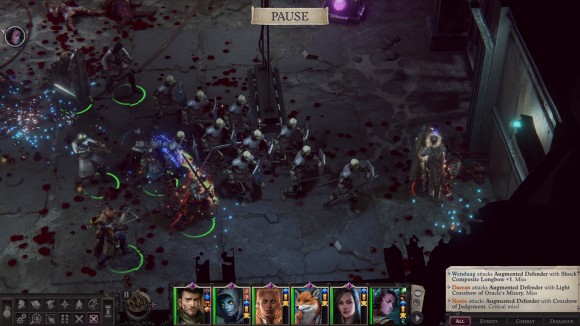
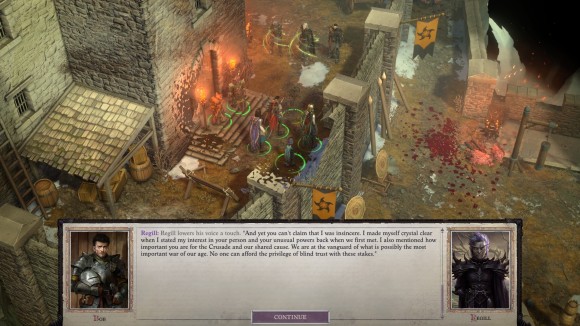
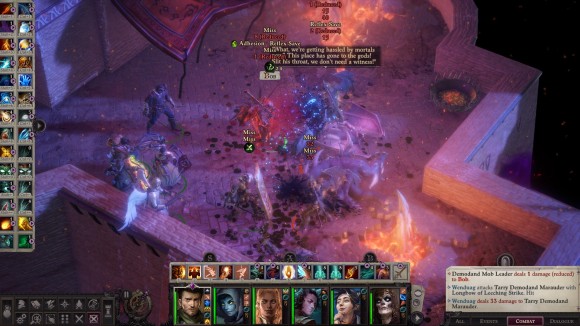
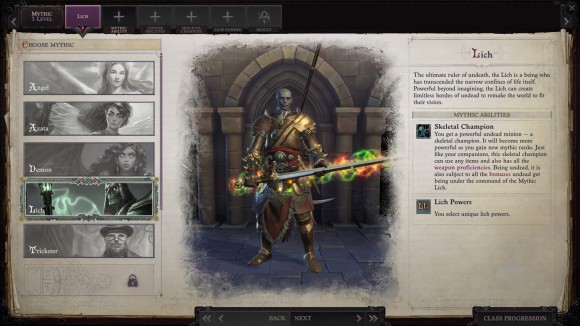
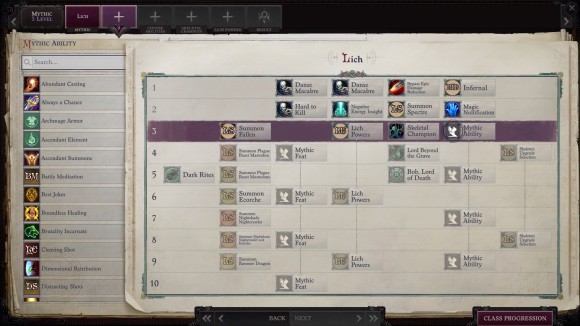
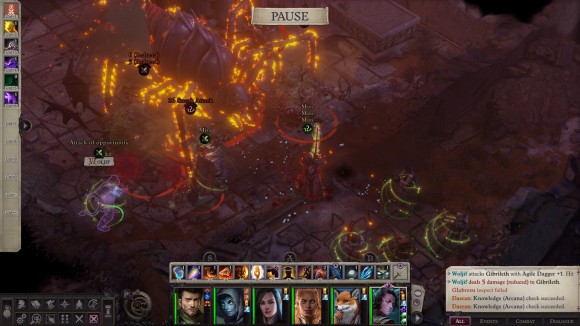
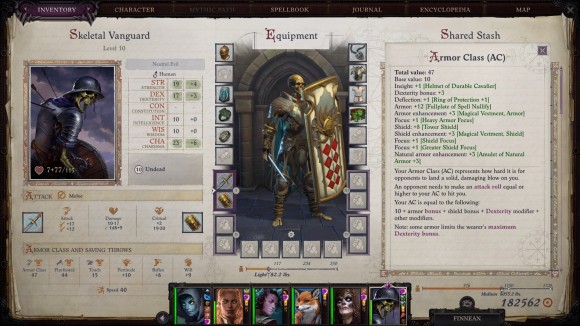
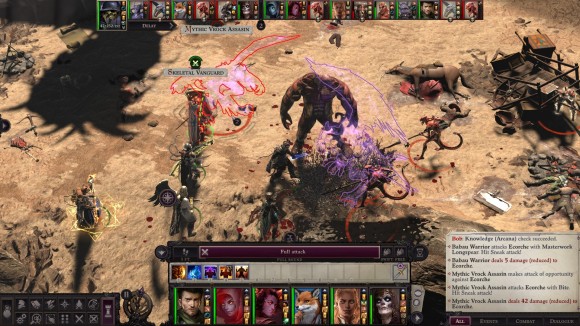
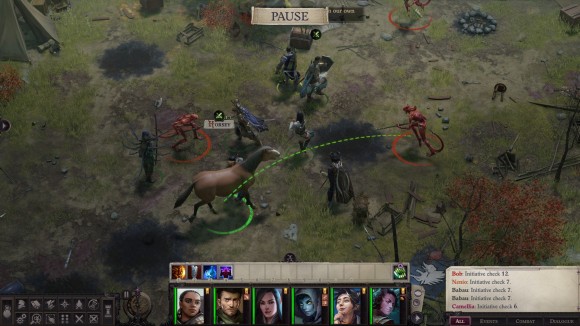
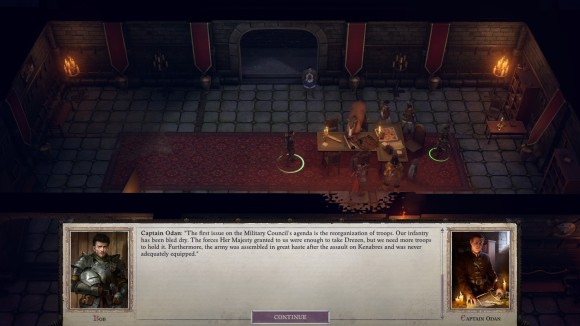
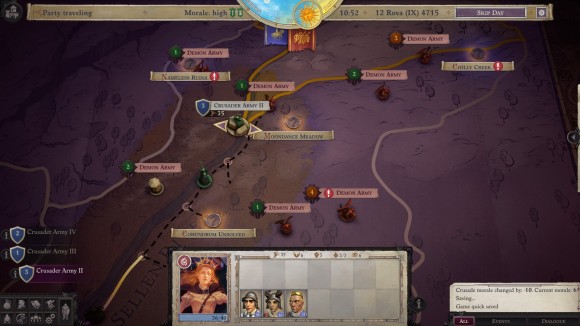
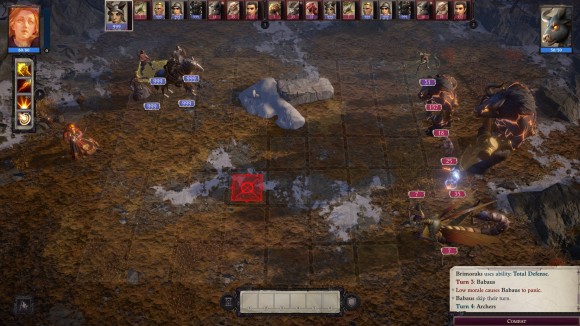
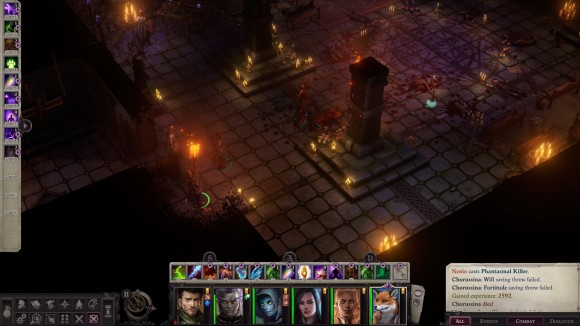
Back when you’ve reviewed Kingmaker I wrote a lot of words about how the game seemed cool but turned out bad, but it still lures me. You said I shouldn’t try to suffer through it again. You were right. I tried again and through most of the game I became fed up. I am now of an opinion that d20 games on PC are inherently bad, and when they’re good it’s in spite of the d20 system.
When I read what people who like those games say it looks to me like they enjoy skipping gameplay. All those broken builds and secret items use doesn’t give you cool abilities, it gives you high stats allowing you to beat everyone with autoattack (as long as you spend several minutes pre-buffing every now and then). I know it sounds like an ignorant “you aren’t actually having fun, you sheeple allowed the game to trick you into having fun” but I saw how good games like Pillars of Eternity 2 give you all the complexity without noob traps and obscure rules and hostility to the player. PoE2 doesn’t felt like a huge achievement to me till I played BG1, Planescape Torment and PFKM, saw how those games usually play and realized how much I took for granted.
Everything I read about WotC is cool but I know it’s the same mess. I’ve played Kingmaker with TB mode already implemented and it helped to understand how the stuff works in the beginning, but later it seemed like there isn’t much you can do in a specific situation except doing obvious stuff (concentrate attacks, heal the wounded), maybe apply short-term buff in an especially difficult fight or reload and use some consumable buffs. People hate kingdom management but for me it was the most interesting part of the game. There were interesting thematic choices to make and it felt like there’s a weight behind decisions made in dialog. Character progression had this feel too, but in d20 you decide on your build when you create a character and then just follow it, you’re not supposed to have interesting choices on levelup.
Maybe one day I get WotC Ultimate Enhanced Director’s Cut and play it on a higher difficulty so that it doesn’t feel like an idle game the way Pathfinder did.. You make it sound like not the worst idea.
I could not get into Kingmaker, even with the turn-based mode (which I agree is overall the superior choice). The encounter balance was all over the map. Chapter 1 was a horrendous slog that saw me spending as much time fiddling with the difficulty options to find a setting that felt tolerable as I did playing, and then Chapter 2 gave me a powerful ranger and a poison bow that made short work of the endless trolls I had to trudge through.
I could never shake the feeling that I would have preferred playing a remake of Neverwinter Nights 2 (which has a nearly identical system) in the engine. NWN2 is just as generic and has plenty of flaws in its own design, but it had a brisk pace that kept things moving.
Honestly, if they dialed down the sheer number of often-quite-challenging combat encounters in favor of fewer, more interesting ones I think I would have enjoyed it a lot more. I might check this one out when it’s patched up and on sale and see if it is the step up you present it as being.
I’ll never play this game but I very much enjoyed your thoughts on it, thank you.